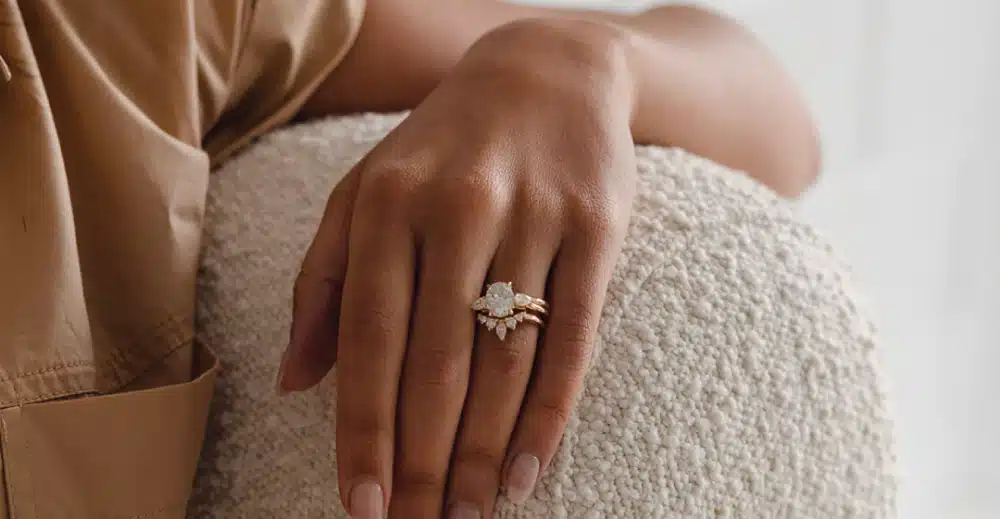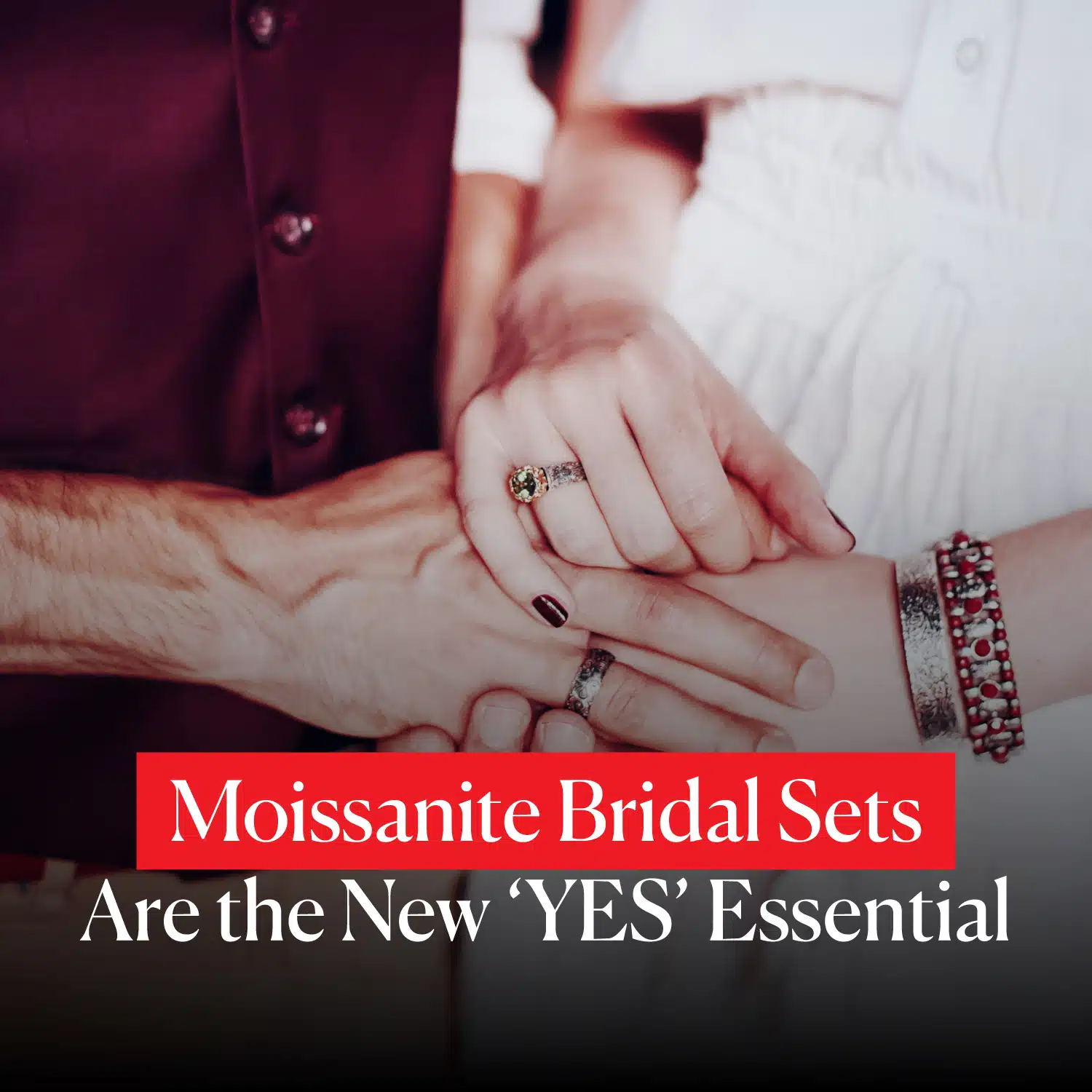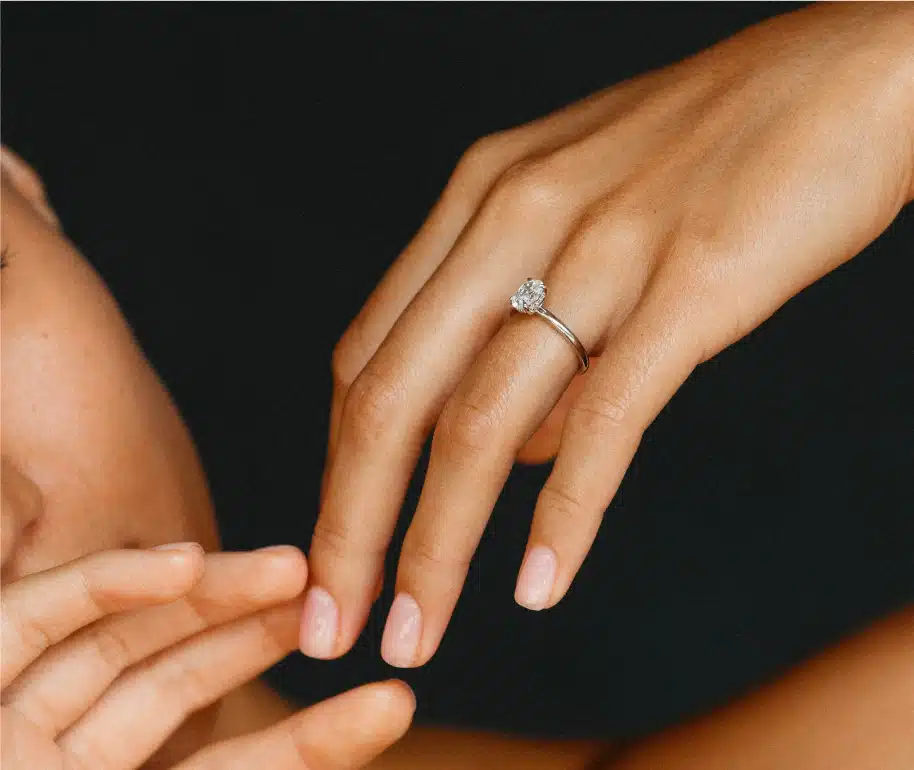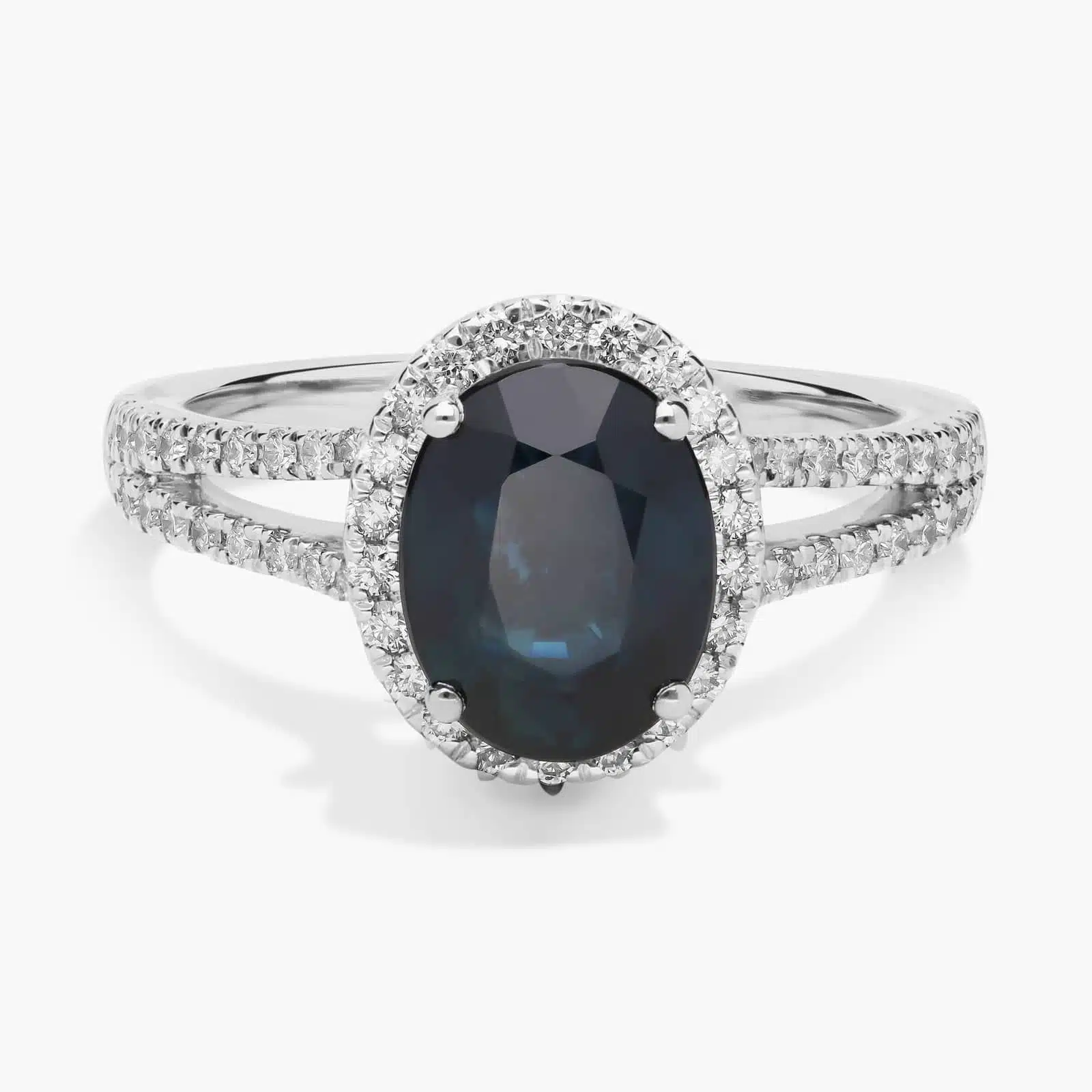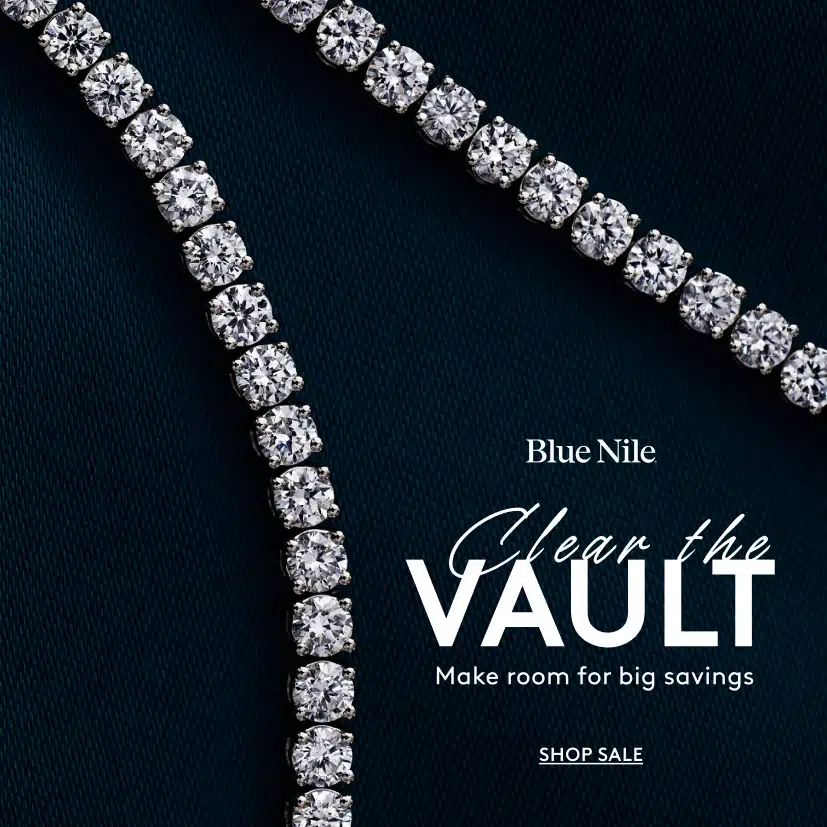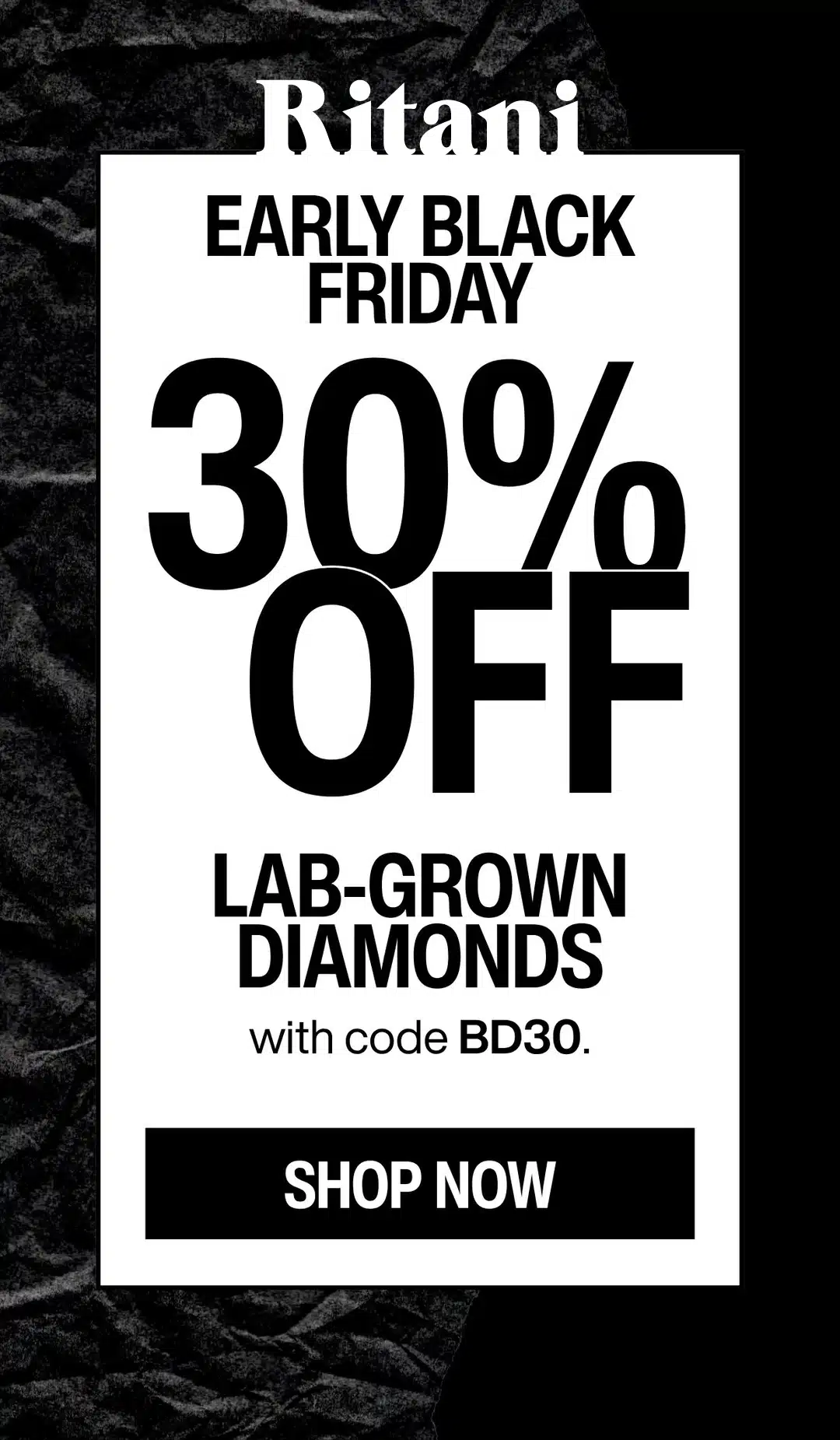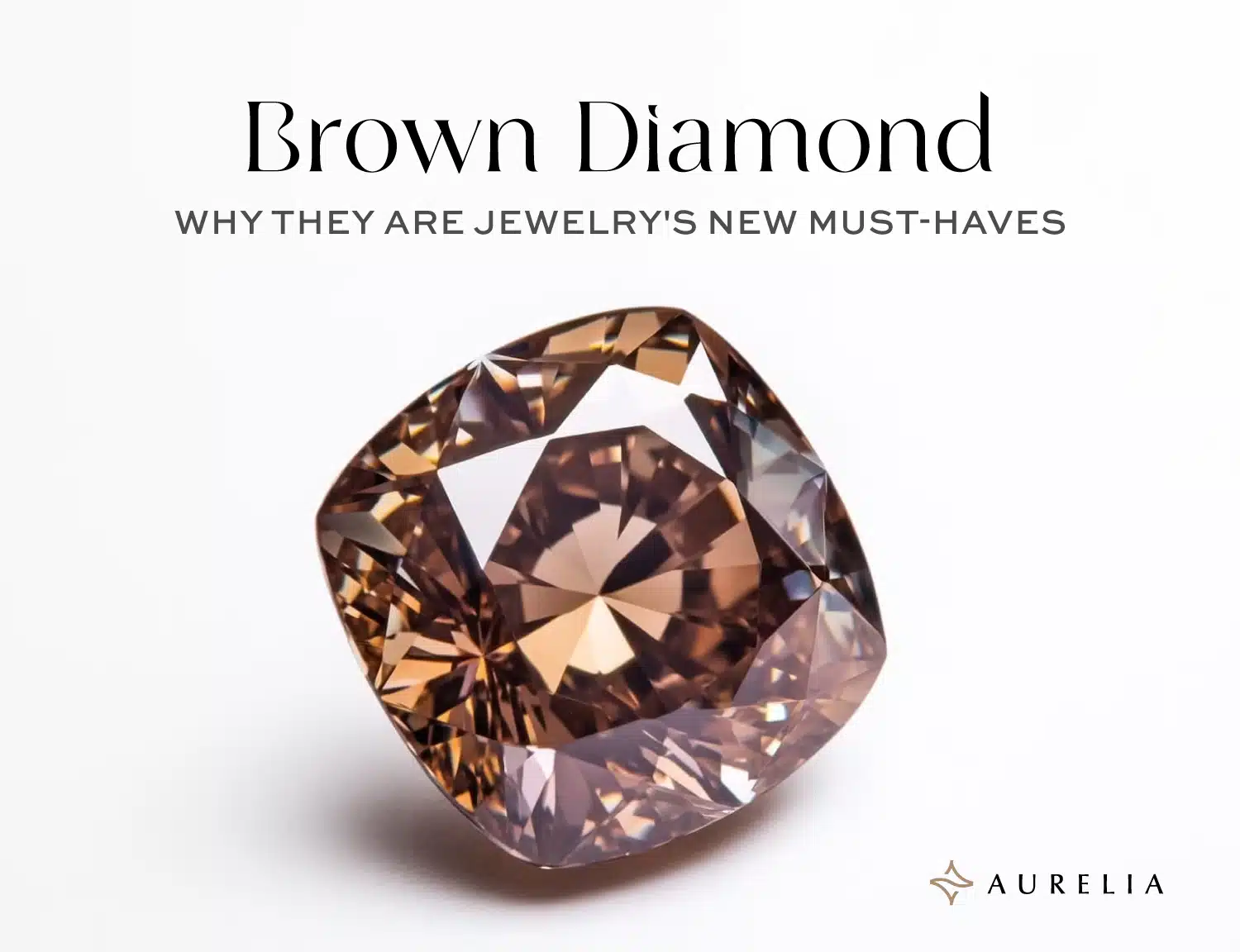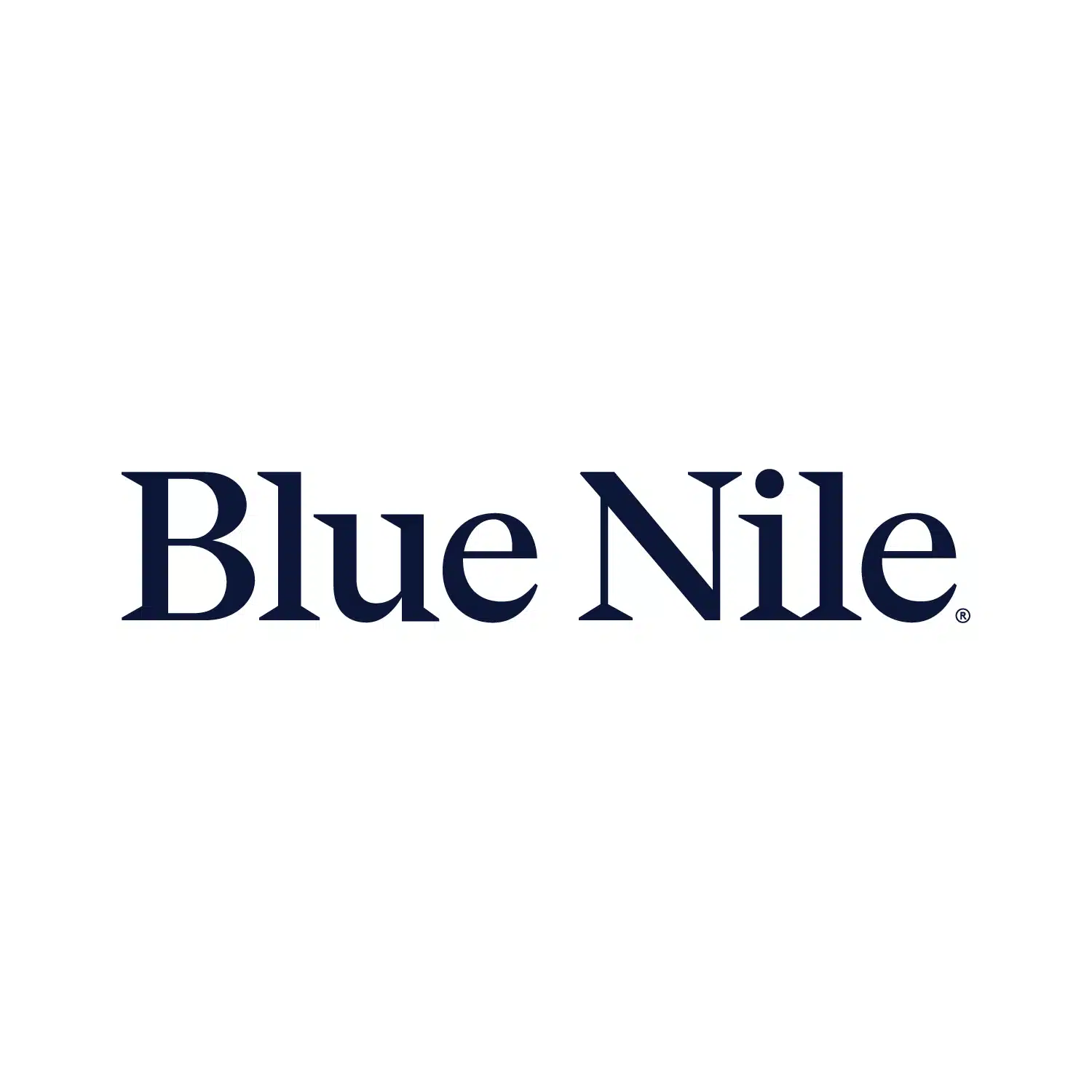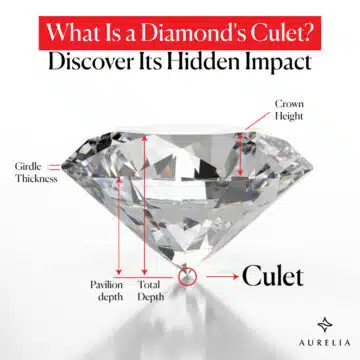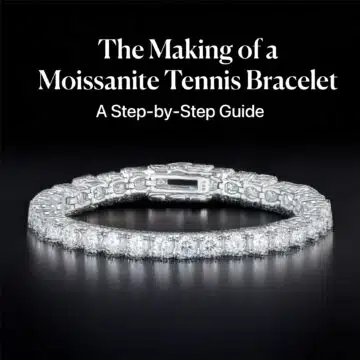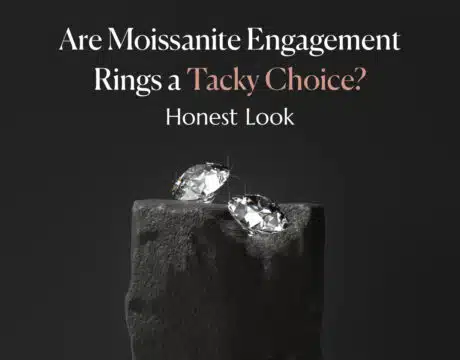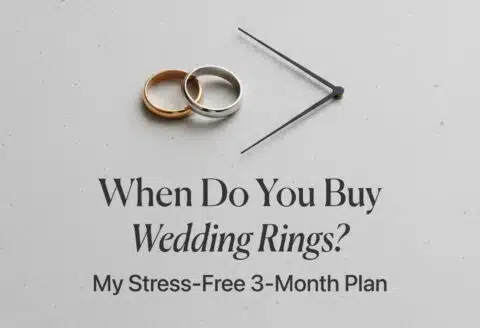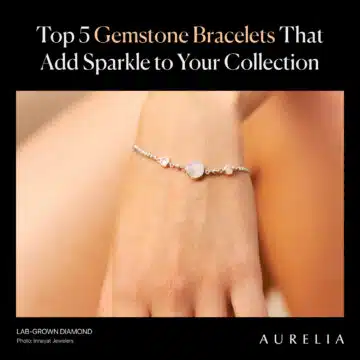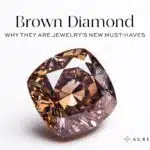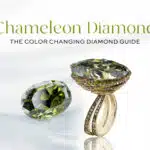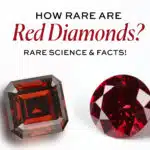Brown diamonds are real, natural diamonds that get their beautiful color—ranging from light champagne to deep cognac—from internal crystal lattice distortions, making them the most affordable and increasingly fashionable of all the fancy colored diamonds.
Let’s be honest. For decades, the brown diamond was the ugly stepsister of the gem world, overlooked and relegated to industrial grit while its colorless sibling went to the ball. But that is the old story.
Today, thanks to a quiet revolution in taste led by style icons like Scarlett Johansson and Kim Kardashian, these warm, earthy “nude” diamonds are the new symbol of understated, chic luxury. They are no longer an “alternative”; they are the first choice for the modern connoisseur.
Deal Alert: Elevate your design. Get up to 30% OFF engagement ring settings at Blue Nile !
One In A Lifetime Sale: “Clear The Vault” – Get up to 70% OFF on select jewelry at Blue Nile !
| Pro Tip: See every detail with 360° HD videos available at James Allen .
That’s why I’ve created the ultimate A-Z guide to what has become the diamond world’s best-kept secret. As your expert guide, I am going to pull back the curtain on everything. We will explore their fascinating history and decode the official industry grading scale that most jewelers won’t tell you about.
We’ll dive into the stories behind the most iconic celebrity rings, I will give you the definitive updated price guide, and most importantly, I will arm you with the knowledge of the critical red flags every buyer needs to know to avoid getting ripped off.
Welcome to the new age of brown diamonds. Let’s begin.
Diamond IQ Test: Natural or Lab-Grown?
Two identical diamonds: GIA Certified, 1.51ct, D Color, VVS1, Ideal Cut. One is natural ($16,530), the other is lab-grown ($2,390). Choose the diamond you like better and see if you can match it to its origin.
What is a Brown Diamond? The Science & History of Earth’s Art
To truly appreciate why brown diamonds are the new must-haves, you have to understand their story. And it is one of the best in the entire gem world. It’s a story of a geological underdog, a diamond born from both trauma and a sprinkle of chemical magic, that went from being an industrial workhorse to a high-fashion icon.
How Do Brown Diamonds Get Their Color? The “Happy Accident”
The secret to a brown diamond’s color is what makes it so fascinating to a gemologist. It’s a happy accident, a beautiful paradox created by two different phenomena working together.
First, and here’s its biggest secret, a brown diamond shares its primary origin story with one of the rarest and most valuable gems on earth: the Pink Diamond. Its color comes from a process called plastic deformation.
This is a scientific way of saying that as the diamond was forming, it was subjected to such incredible, violent pressure from multiple directions that its internal crystal lattice was literally twisted and strained. This “trauma” alters how light passes through the diamond, producing color.
But that’s only half the story. The brown diamond also has a dash of the same magic that creates a Yellow Diamond. Trapped within its structure are trace amounts of nitrogen. It is the chaotic, beautiful mixture of these two events—the structural strain of plastic deformation plus the presence of nitrogen impurities—that absorbs light in such a unique way that our eyes perceive it as a beautiful, warm brown.
It’s a gem born from both pressure and impurities, a unique event that could only happen under the most extreme conditions imaginable, a topic we explore in my complete guide, At What Depth is Diamond Found?.
The History: From Industrial Grit to Modern Luxury
For the longest time, brown diamonds weren’t just unpopular; they were unwanted. Throughout much of the 20th century, the jewelry industry was obsessed with the ideal of the “perfect” colorless white diamond. Any stone with a noticeable brown tint was considered inferior, low-grade, and suitable only for industrial purposes—often crushed into grit for saws and polishing wheels.
Then, in the 1980s, one of the most brilliant marketing masterstrokes in jewelry history happened.
The Argyle Mine in Australia had begun producing a massive volume of these beautiful, but unfashionable, brown diamonds. Instead of selling them for industrial prices, they launched a revolutionary marketing campaign.
They got rid of the boring, technical “brown” and gave them new, incredibly appealing names that evoked luxury, celebration, and warmth. Suddenly, these weren’t “brown” diamonds anymore. They were:
- “Champagne Diamonds” for the light, bubbly, golden-brown stones.
- “Cognac Diamonds” for the deeper, richer, reddish-brown stones.
It was pure genius. It changed public perception forever and transformed an overlooked stone into a desirable gem.
My Expert Take: “It’s incredible to think that today, that very same type of stone that might have been crushed into grit 50 years ago is now the treasured centerpiece of a gorgeous ring.”
Just look at this beautiful GIA 1.02 Carat Fancy Yellow Brown-VS2 Round Cut Diamond from James Allen for $3,740. It is a perfect example of a “Champagne” colored stone—warm, brilliant, and full of life.
This revolution in thinking paved the way for the modern appreciation of all colored diamonds and helped create the vibrant market we see today, with the Best Places to Buy Engagement Rings Online now proudly showcasing these incredible gems.
The Brown Diamond Spectrum: From Champagne to Cognac
Now, let’s get to the fun part. The marketers who rebranded the brown diamond were brilliant. They took a simple color and gave it a menu of delicious-sounding names that evoke luxury, celebration, and warmth. But as your “friend in the business,” I want you to know what these names actually mean in the real world. Let’s crack the code together.
Champagne Diamonds: The Light & Bubbly Hue
This is the name you’ll hear most often. When a jeweler says “Champagne Diamond,” they are referring to a lighter brown diamond, almost always with a noticeable secondary yellowish hue.
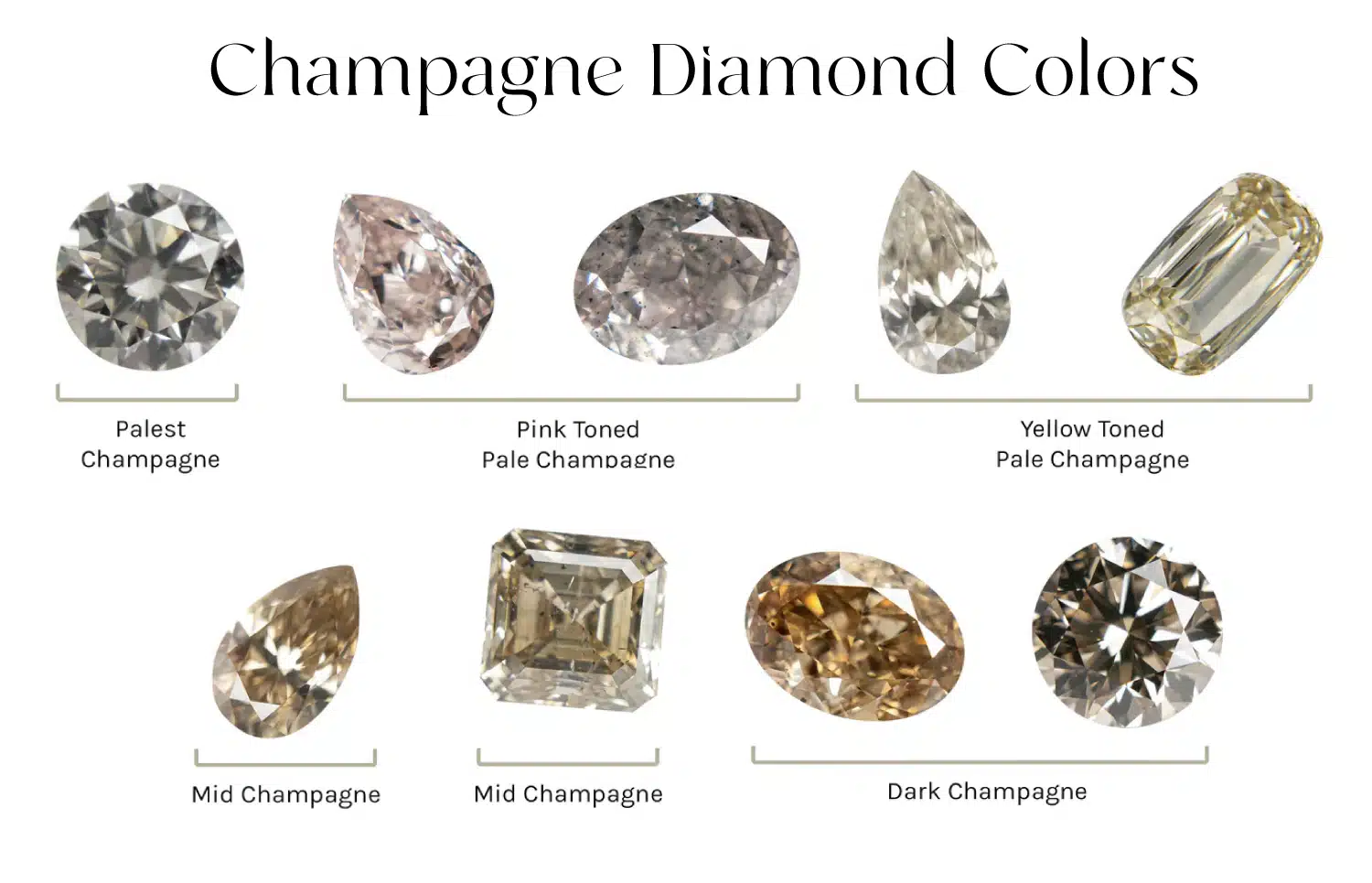
What It Looks Like: Think of the color of a glass of bubbly. It’s a bright, effervescent, golden-brown. It’s the sunnier, more vibrant end of the brown spectrum.
Mehedi’s Take: I love champagne diamonds because they offer a beautiful warmth without being dark. They have a bright, lively energy and look absolutely incredible in yellow or rose gold. They are the perfect “starter” brown diamond for someone who wants a unique look that’s still light and full of sparkle.
Take a look at this stunning GIA 1.03 Carat Fancy Yellowish Brown-VS2 Heart Shaped Diamond from James Allen for $3,760. That “Yellowish Brown” designation on the GIA report is the very definition of a champagne diamond.
It’s a fantastic value for a stone with such a distinct personality, especially with a great clarity grade like VS2. To understand why a VS2 offers such incredible value, you should read my deep-dive on VS2 Diamond Clarity.
Cognac Diamonds: The Rich & Warm Spirit
If Champagne is the bubbly aperitif, “Cognac Diamond” is the rich, warm after-dinner drink. This name refers to deeper, richer brown diamonds, almost always with a noticeable secondary reddish or orangey hue.

What It Looks Like: Think of the color of aged brandy in a glass. It’s a deep, warm, and sophisticated color with a fiery, smoldering presence.
Mehedi’s Take: Cognac diamonds have a moody, romantic, and very luxurious feel. The reddish and orangey undertones give them an incredible depth that you just don’t see in lighter champagne stones. They are for the person who wants a diamond with a bold, confident, and sophisticated personality.
This GIA 1.63 Carat Fancy Brown Orange-VS1 Pear Shaped Diamond from James Allen, at $4,180, is a perfect example of a cognac diamond. That “Brown Orange” color grade tells you it has those rich, warm undertones.
A unique shape like this only adds to its character. You can learn more about this elegant cut in my definitive Pear-Shaped Diamond Buying Guide.
Beyond the Bar: Whiskey, Coffee, Cinnamon & Honey
While Champagne and Cognac are the two main categories, you’ll sometimes hear other delicious-sounding names. These are generally more specific “tasting notes” to describe a particular shade.
- Whiskey: A deep brown, often with less red than a Cognac.
- Coffee: The darkest, most saturated, near-opaque browns.
- Cinnamon: A beautiful brown with a distinct reddish or spicy undertone.
- Honey: A warm, golden-brown that’s a bit richer than a classic champagne.
My Expert Take: “These names are beautiful, but they are subjective. The most important thing is to look at the GIA report for the official color grade, and then decide if the ‘flavor’ of the stone is right for you.”
A great example of a deep ‘coffee’ brown would be this GIA 4.23 Carat Fancy Brown Round Cut Diamond from James Allen. At $20,270, it is a stone with a deep, rich, and powerful presence.
Ultimately, all of these names are just a way of helping you find a unique stone that perfectly matches your personal style. For a complete overview of all the incredible looks you can achieve, check out my comprehensive Diamond Shapes Guide.
Best Deal Of The Year – Final Days
Blue Nile’s “Clear The Vault” is ON.
Shop Fine Jewelry Upto 70% OFF.
*Exclusions may apply. See Blue Nile for complete details.
The Official Grading Scale: Speaking the Language of Argyle
Alright, this is where I’m going to let you in on an industry secret. The names “Champagne” and “Cognac” are beautiful, evocative, and fantastic for marketing. But if you want to speak like an expert—if you want to understand the real language of the brown diamond trade—you need to learn to speak “Argyle.”
Mehedi’s Intro: “While names like ‘Champagne’ are beautiful, if you want to speak like an expert, you need to speak the language of the source: the Argyle mine.
They unearthed such a massive volume of these stones that they created the definitive C1-C7 grading scale for brown diamonds, and to this day, it is the industry standard that GIA and other professionals use as a benchmark.”
This “C-Scale” (for Cognac) is a simple and brilliant way to classify the saturation and tone of a brown diamond.
The C-Scale Breakdown

This is the official framework that connects the marketing names to the gemological reality.
| C-Scale Grade | Argyle’s Description | What It Really Looks Like (Common Name) |
| C1–C2 | Light Brown | Light Champagne: a pale, golden-straw color. |
| C3–C4 | Medium Brown | Medium Champagne: a classic, bubbly, golden-brown hue. |
| C5–C6 | Dark Brown | Dark Champagne / Light Cognac: a richer, deeper bronze or toffee color. |
| C7 | Deepest Brown | Fancy Cognac: the richest, most saturated, deep reddish-brown. |
Let’s look at some real-world examples to see this scale in action. A beautiful stone like this GIA 1.01 Carat Fancy Orange Brown-VVS2 Cushion Modified Cut Diamond from James Allen, priced at $4,130, would likely fall in the C5-C6 range, displaying that gorgeous “Light Cognac” color with an excellent VVS2 clarity. Understanding a high clarity grade is key, which I cover in my deep-dive on VVS2 Diamond Meaning & Cost.
On the lighter end, a stone like this GIA 1.01 Carat Fancy Yellow Brown-VS2 Oval Cut Diamond from Blue Nile for $3,690 would be a classic example of the C3-C4 “Medium Champagne” range.
The “Chocolate Diamond®” Legal Loophole
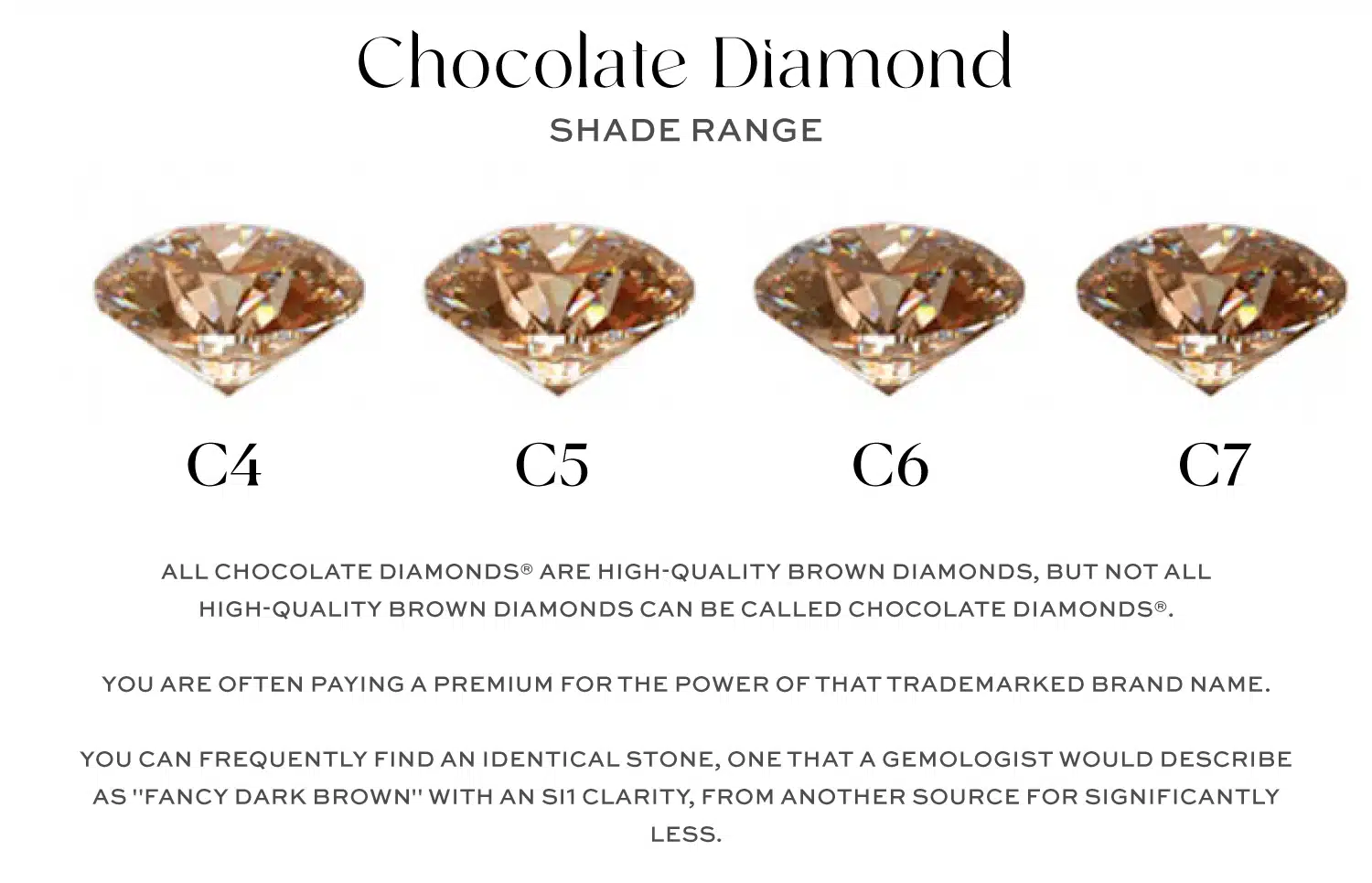
Now for a crucial piece of insider knowledge that could save you a significant amount of money. You’ve heard the term “Chocolate Diamond®,” and you’ve probably seen the commercials. But you need to know what it really is.
Mehedi’s Insider Info: “Did you know a jeweler cannot legally sell a diamond as a ‘Chocolate Diamond®’ unless it is from the jewelry brand Le Vian? That name is a registered trademark, not a gemological term. Le Vian has brilliantly defined their trademarked diamonds as a stone in the C4–C7 color range with an SI clarity or better.”
What does this mean for you?
- All Chocolate Diamonds® are high-quality brown diamonds, but not all high-quality brown diamonds can be called Chocolate Diamonds®.
- You are often paying a premium for the power of that trademarked brand name.
- You can frequently find an identical stone, one that a gemologist would describe as “Fancy Dark Brown” with an SI1 clarity, from another source for significantly less.
For example, this stunning GIA 2.50 Carat Fancy Orange Brown-SI2 Round Cut Diamond from Blue Nile, at $17,610, fits the “Chocolate Diamond®” color criteria beautifully. Because it isn’t trademarked, you are paying for the quality of the stone, not the brand name.
It’s a key lesson in knowing where your money is going, something we discuss in our brand-vs-brand showdown, Zales vs. Blue Nile.
The Argyle Event: A 2020 Supply Shock & The New Investment Angle
For decades, the story of the brown diamond included a key fact: they were abundant. While all fancy colors are rare, the reliable, high-volume production from one specific source kept the market well-supplied. But that story has now come to a sudden and dramatic end, and this is the “insider” secret that savvy buyers need to understand in 2025.
The Mehedi Hook: “For over 30 years, one mine—the Argyle mine in Australia—was a geological freak of nature. It pumped out a huge percentage of the world’s fancy diamonds, including almost all of its iconic pinks and a massive volume of its finest cognacs.
In November 2020, it closed. Forever. This single event transformed brown diamonds from an ‘abundant’ resource into a ‘heritage asset.’ If you buy an Argyle-certified brown diamond today, you aren’t just buying jewelry; you are buying a piece of extinct history.”
What This Means For You, The Buyer
This isn’t just a small detail in a long history; it is a fundamental shift in the very nature of the brown diamond market. The most consistent and abundant source of high-quality brown diamonds is now gone. The tap has been turned off, and the diamonds that are already out in the world are all that are left from this legendary source.
This has created two exciting opportunities for you as a buyer:
A Finite, Collectible Asset
Any brown diamond with a certificate that verifies its origin as the Argyle mine has now become a finite, collectible piece. The supply is known and limited. Just as with the ultra-rare Red Diamonds that were famously found at Argyle, the mine’s name now carries a historical premium. It has become a pedigree, a mark of a special and ever-dwindling group of stones.
The New Investment Angle
For the first time in their history, certain brown diamonds now have a strong potential for future value appreciation. As the market slowly feels the effects of this supply shock, the demand for these warm, beautiful, and now “historical” stones is likely to rise.
A top-quality C7 “Fancy Cognac” or a “Fancy Pinkish Brown” from the Argyle mine is no longer just a beautiful gem; it is a smart acquisition for a savvy buyer who is thinking about the future.
Just look at the value that a pink modifier adds. This gorgeous GIA 1.00 Carat Fancy Pinkish Brown-VS1 Pear Shaped Diamond from James Allen, at $7,780, commands a premium because that touch of pink connects it to Argyle’s most famous and valuable legacy.
James Allen: Our 5-Star Choice for Price and Selection
Check our comprehensive James Allen Review to learn more about their pricing and commitment.
The Argyle event has transformed the way we should look at a brown diamond, turning it from a simple purchase into a potential piece of a savvy investment portfolio, a concept we explore in my guide on How to Trade In Your Diamond for an Upgrade.
The A-List Accessory: Iconic Celebrity Brown Diamond Rings
For a long time, the brown diamond was a gemological wallflower. But then, as it always does, fashion changed. A few key tastemakers and style icons saw the hidden beauty in these earthy, warm stones, and a revolution began.
These are the celebrity moments that transformed the humble brown diamond into a symbol of sophisticated, modern luxury.
Scarlett Johansson: The Ring That Changed the Game
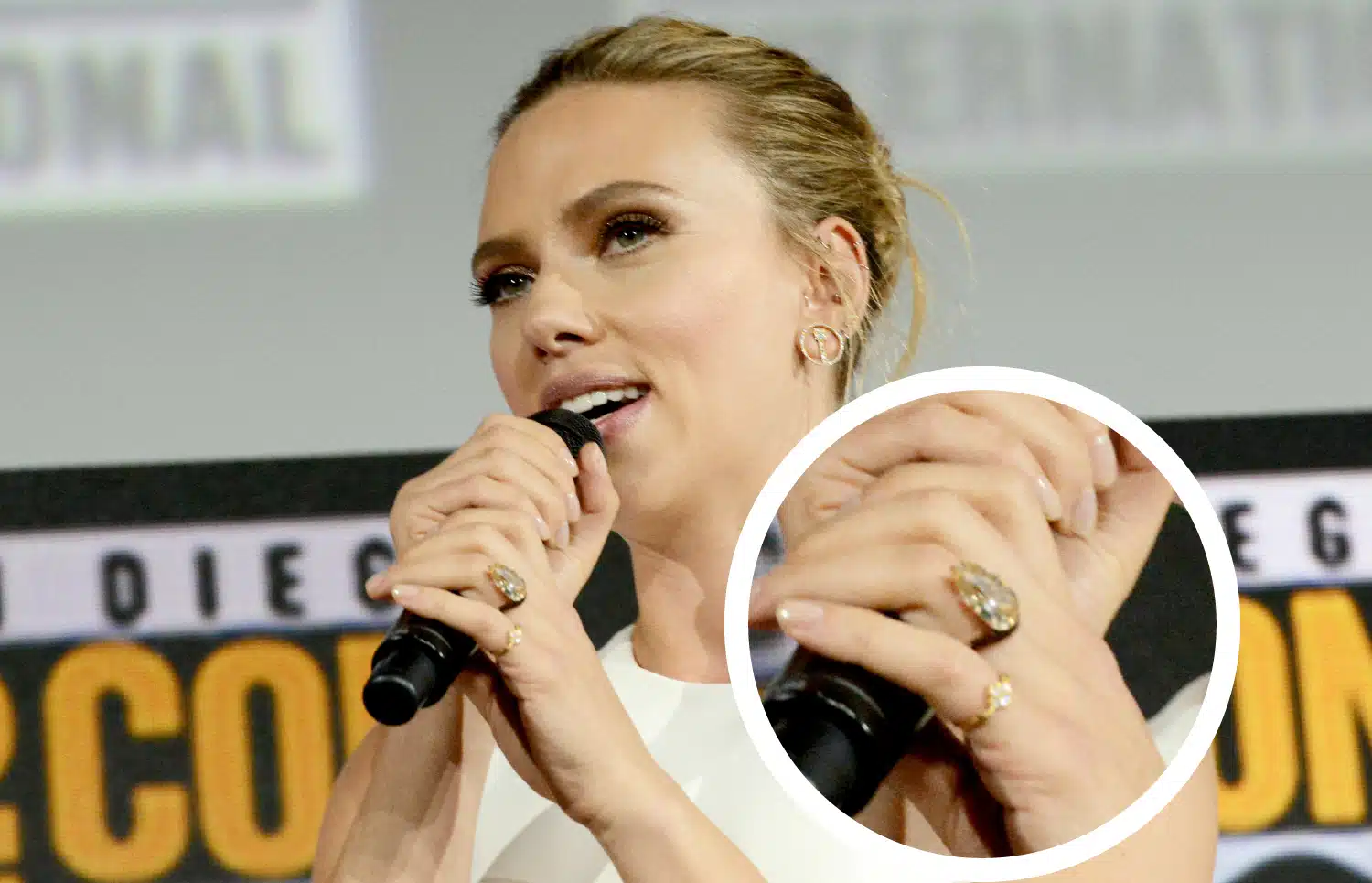
This was the moment. In 2019, when Scarlett Johansson debuted her engagement ring from Colin Jost, the collective jewelry world did a double-take. It wasn’t a traditional white diamond. It wasn’t a flashy colored gem. It was something entirely different, and it instantly redefined “cool” in the world of bridal jewelry.
- The Ring: A magnificent 11-carat, light brown, oval-shaped diamond.
- The Masterstroke: It was designed by the legendary tastemaker James de Givenchy of Taffin and set on a completely unexpected, avant-garde dark brown ceramic band.
My Expert Take: “This ring was a cultural reset. The choice of a soft, light brown diamond wasn’t a compromise; it was the entire point. It was a move away from flashy brilliance and toward a personal, chic, and understated luxury.
Paired with that dark, curving band, it wasn’t just a ring; it was a piece of art. This was the moment a brown diamond went from being ‘alternative’ to ‘high fashion.'”
A similar large, beautiful oval shape, like this GIA 5.68 Carat Fancy Brown-VVS2 Oval Cut Diamond from James Allen for $7,730, offers a hint of that same bold, elegant look.
Kate Hudson: The Modern Romantic
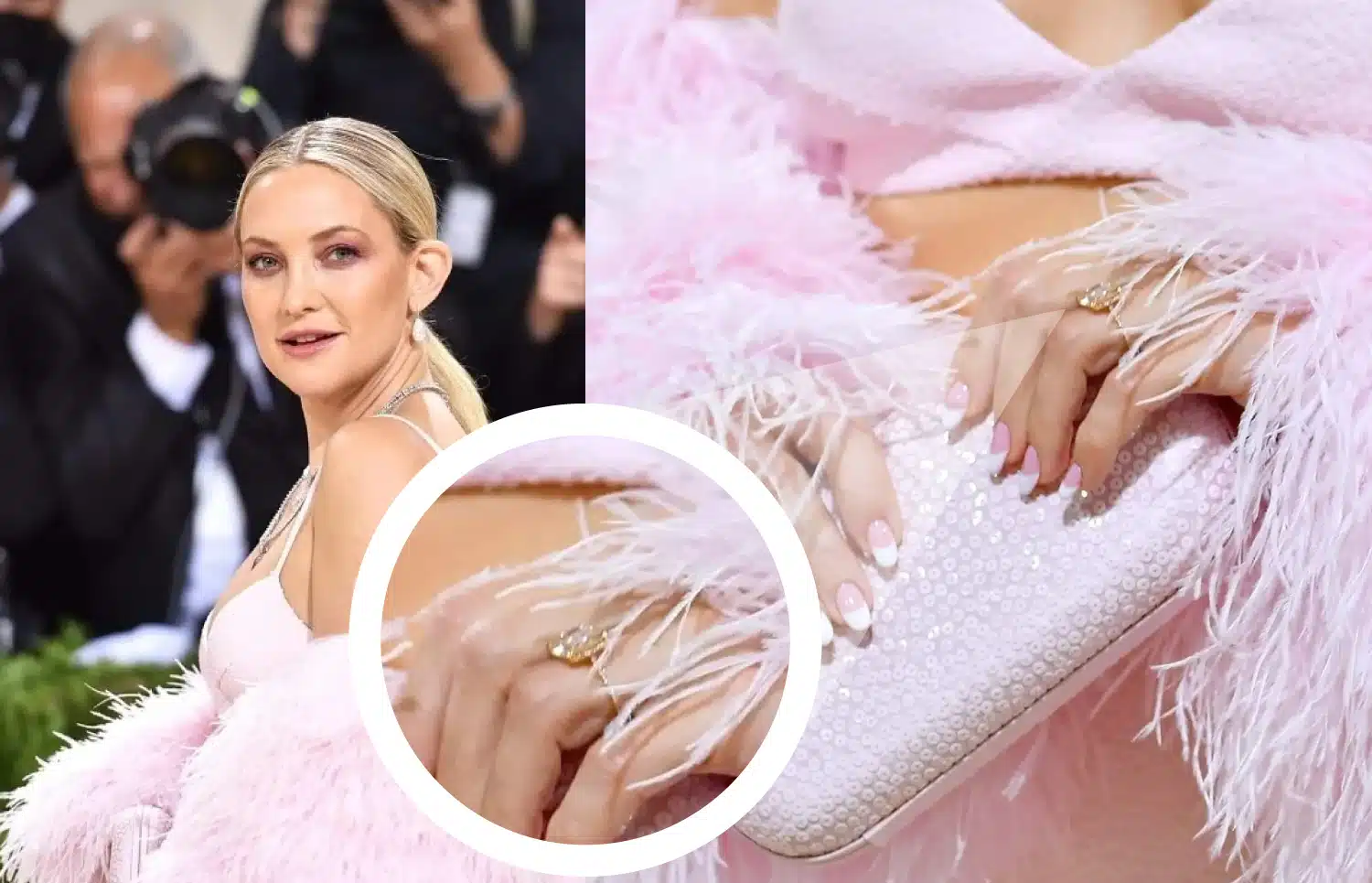
If Scarlett’s ring was the high-fashion art piece, Kate Hudson’s engagement ring from Danny Fujikawa in 2021 was its romantic counterpart. She debuted the stunning ring at the Met Gala, showcasing a softer, warmer, and equally chic take on the brown diamond.
- The Ring: A beautiful light brown, elongated cushion-cut diamond.
- The Perfect Setting: A delicate and romantic rose gold pavé band, custom-designed by superstar jeweler Lorraine Schwartz.
My Expert Take: “This ring is a masterclass in tone and harmony. The choice of rose gold was perfection. It complements the warm, rosy undertones of the light brown diamond, creating a seamless, romantic, and feminine look. It’s less of a high-contrast statement and more of a beautiful, warm glow on her finger.”
You can see this beautiful color harmony in a piece like this GIA 1.00 Carat Fancy Pinkish Brown-VS1 Pear Shaped Diamond from Blue Nile for $7,780, where the pink and brown tones are a match made in heaven. Learn more about cushion cuts in our dedicated Cushion Cut Diamond Guide.
Kim Kardashian: The Undisputed Queen of Nude Diamonds

No one has done more to keep the brown diamond in the spotlight than Kim Kardashian. For years, she has championed what her favorite jeweler, Lorraine Schwartz, calls “nude diamonds”—a whole spectrum of champagne, cognac, and brown hues that complement a sophisticated, neutral palette.
Most recently, at the high-profile Bezos wedding in June 2025, she paired a slinky brown gown with a spectacular statement brown diamond necklace from Moussaieff. Her continued love for these warm-hued stones proves they are not just a fleeting trend but a core part of the modern luxury aesthetic.
Her influence has made a huge impact, a phenomenon we also see with other colored gems in my guide to the Most Iconic Yellow Diamond Engagement Rings.
The Designer Darling: How High Fashion Embraced Brown
It’s not just the stars; it’s the people who dress them. Influential, high-end designers like Sylva & Cie are now championing what they call “big, juicy, brown diamonds” as the centerpieces of their most important statement rings.
This is a critical shift. For designers on the cutting edge of fashion, brown diamonds are no longer just an “affordable alternative”; they are a first-choice gem for their soft, warm, and sophisticated color. As designer Sylva Yepremian says,
“They are still bright and refractive like a white diamond, but their ‘nude’ hue is softer, especially for daytime and everyday wear.”
This embrace by high fashion solidifies the brown diamond as a modern essential. Getting this kind of unique, personal style is the entire point of custom design, a philosophy we explore in my Taylor & Hart Review.
Brown Diamond Price Guide: The Ultimate Value Proposition
Alright, let’s talk about the best part: the money. The single greatest reason that brown diamonds have become a modern must-have is because they offer the most incredible value in the entire diamond world. But “value” can be complex.
As your guide, I’m going to walk you through the updated market for both natural and lab-grown stones, using real-world examples to show you how to get the most beautiful stone for your budget.
Reality #1: The Natural Brown Diamond Market
The market for natural brown diamonds is a paradise for the savvy buyer. It’s the one place where you can get a large, beautiful, natural diamond with a unique personality without needing a millionaire’s budget.
Looking at high-profile auctions gives us a fascinating insight into brown diamond value.
- The “Bargain” Behemoth: In a stunning 2022 result, the historic 111.59-carat “Earth Star” diamond, a Fancy Deep Orange-Brown, sold for a surprisingly low $693,000. For a stone of this size, that is an absolute bargain, proving the incredible value large brown diamonds can offer.
- The Power of Pink: By contrast, a recent 2025 Christie’s auction saw an 18.72-carat light brown-pink diamond sell for $567,000. Even though it was much smaller, that hint of a pink modifier added immense value. This is a lesson we see time and again with rare gems like the Red Diamond, where a secondary color can change everything.
Let’s translate this to what you can actually buy today.
The 1-Carat Sweet Spot:The value here is astounding. Look at this gorgeous GIA 1.01 Carat Fancy Orange Brown-VS2 Heart Shaped Diamond from Blue Nile for just $3,690. A one-carat, natural diamond with a beautiful, warm color and a great clarity grade for under $4,000.
For context, a standard colorless diamond of this size and quality would cost significantly more. We compare the values in my 1 Carat Diamond vs Moissanite guide.
The Modifier Effect: How “Pink” Changes the Game
Want to see the true power of a fancy colored diamond modifier? The price difference between a stone with a hint of pink and a stone where pink is the primary hue is staggering.
- The Affordable Upgrade (Pinkish Modifier): First, look at this gorgeous GIA 1.00 Carat Fancy Pinkish Brown-VS1 Pear Shaped Diamond from James Allen, priced at $7,780. That desirable “Pinkish” hue, often a legacy of the famed Argyle mine, more than doubles the price compared to a pure brown diamond.
- The Investment-Grade Jump (Pink Modifier): Now see the exponential jump in value. This GIA 1.10 Carat Fancy Pink Brown-VVS2 Oval Cut Diamond from Blue Nile commands an incredible $60,200. The classification has shifted from Pinkish Brown to Pink Brown, meaning the coveted pink is now a much stronger component—a near-tenfold increase in cost for a stone just 0.10 carats larger!
Read Our 5-Star Blue Nile Review
Check our comprehensive Blue Nile review to learn why we rated Blue Nile 5 stars for their exceptional quality and value.
Going Big Without Going Broke
This is where brown diamonds truly shine and offer unbeatable value for sheer size. You can acquire a massive, head-turning stone for a fraction of what a colorless diamond costs.
- The 5-Carat Mark: Look at this huge GIA 5.01 Carat Fancy Yellow Brown-SI2 Pear Shaped Diamond from Blue Nile, priced at an unbelievable $14,860. For context, a 5-carat colorless diamond of comparable quality would easily cost over ten times that amount.
- The Colossal 20-Carat Statement: You can even go further and get a colossal GIA 20.05 Carat Fancy Yellowish Brown-VS1 Radiant Cut Diamond from Blue Nile for approximately $205,310. That price would barely cover a 2-carat fine colorless diamond at the highest grades, demonstrating the unique value proposition of brown stones.
Now for a critical piece of buyer protection. Not all brown diamonds are a good deal. You must watch out for two major value-killers.
1. The “Muddy” Modifiers: Greenish & Grayish Hues
I’ve seen countless “cheap” brown diamonds that are cheap for a reason. They have a secondary Greenish or Grayish hue. Unless you are specifically looking for an olive or industrial look, these modifiers kill the warmth of the stone, making it look dull and “muddy” rather than rich and honey-toned.
Notice this GIA 4.07 Carat Fancy Greenish Yellow Brown-SI2 Cushion Modified Cut Diamond on James Allen is $15,240, significantly less than other stones of its size.
2. The Fluorescence Double-Edged Sword
You must pay attention to fluorescence. In white diamonds, it can sometimes be a good thing. In brown diamonds, Medium to Strong Blue Fluorescence is usually a disaster.
Mehedi’s Tip: “Avoid ‘Medium’ or ‘Strong’ Blue Fluorescence in brown diamonds. It creates a chemical reaction with the brown body color that results in a hazy, oily, or milky appearance, completely ruining the rich cognac color. Stick to ‘None’ or ‘Faint’ fluorescence. It is a critical detail I cover in my full guide, Diamond Fluorescence: Flaw or Feature?.”
Reality #2: The Lab-Grown Brown Diamond
If you’re looking for the absolute smartest sparkle for your budget, a lab-grown brown diamond is an incredible choice. Options are rarer than for other colors, but the value is immense when you find one. They are real, beautiful diamonds, and you can learn about their certification in my guide to GIA Certification.
The options for lab-grown brown diamonds are few but mighty. Look at this beautiful IGI 1.41 Carat Fancy Orange Brown-VS1 Oval Cut Lab-Grown Diamond from Blue Nile for just $980. A real, certified diamond over a carat for under $1,000 is an absolutely unbeatable proposition.
The Bottom Line: A Carat-by-Carat Price Breakdown for 2025
We’ve talked about the celebrities, the marketing, and the geology. Now, let’s get down to the hard numbers. This is the ultimate “cheat sheet”—the section where I pull back the curtain on what these beautiful brown diamonds actually cost.
The difference between the natural and lab-grown markets isn’t just a gap; it’s a completely different universe of value, and you deserve to see the real data.
The prices below are based on my analysis of current market data and the real-world listings at top retailers like James Allen and Blue Nile for high-quality, GIA or IGI certified brown diamonds.
| Carat Weight | Natural Brown Diamond (Price Per Carat) | Lab-Grown Brown Diamond (Price Per Carat) | Mehedi’s Expert Notes |
| 0.50 Carat | $1,500 – $3,500+ | ~$700 – $1,000 | The entry point for a beautiful, natural brown diamond. In lab, you get an incredible stone for less than a nice dinner out. |
| 1.00 Carat | $2,500 – $6,000+ | ~$700 – $1,300 | This is the sweet spot for natural diamond value. A stone like the GIA 1.01 Carat Fancy Orange Brown-VS2 for $3,690 offers a huge look for the price. |
| 2.00 Carat | $3,500 – $8,000+ | ~$1,300 – $1,800 | A 2-carat natural stone like the GIA 2.01 Carat Fancy Yellowish Brown-SI1 for $8,460 is an attainable showstopper. In lab, like the IGI 2.01ct Fancy Brown-VVS2 for $2,600, it’s an unbelievable value. |
| 3.00 Carat | $3,000 – $7,000+ | N/A (Extremely Rare) | The per-carat price for natural stones can sometimes dip here due to lower demand for very large sizes. You can find a GIA 3.11 Carat Fancy Yellow Brown for just $7,400. |
| 5.00+ Carat | $4,000 – $15,000+ | N/A (Extremely Rare) | The pinnacle of attainable luxury. A huge GIA 5.03 Carat Fancy Yellow Brown-VVS2 for under $30,000 is a testament to the incredible value natural brown diamonds offer. |
The value chasm between natural and lab-grown here is staggering. For under $1,000, you can acquire a beautiful 1.41 Carat Fancy Orange Brown Lab Diamond from Blue Nile—a real, certified diamond that is beautiful and durable.
However, the real story is in the incredible, attainable luxury of the natural brown diamond. Where else in the world of diamonds can you acquire a massive, 5-carat natural diamond like the GIA 5.01 Carat Fancy Yellow Brown from Blue Nile for under $15,000? It is, without a doubt, the single greatest value proposition in the entire natural diamond market.
Now, there is one major exception to these value prices, and it is the magic of a “pink” modifier. The moment the word “Pinkish” appears on a GIA report, the value multiplies.
- A 1.00 Carat Fancy Brown Diamond might be $3,000.
- A 1.00 Carat Fancy Pinkish Brown Diamond, like this gorgeous GIA 1.00 Carat stone from James Allen, commands a price of $7,780.
- An even larger 2.51 Carat Fancy Pink Brown stone soars to $71,990.
That hint of pink, a legacy of the famed Argyle mine, connects the stone to the rarity of its most famous sibling, the Pink Diamond, and the price rises accordingly. It is the ultimate lesson in how a single word on a certificate can be worth tens of thousands of dollars, a core principle in understanding the Definition of a Diamond Appraisal.
Deal Alert: Elevate your design. Get up to 30% OFF engagement ring settings at Blue Nile !
One In A Lifetime Sale: “Clear The Vault” – Get up to 70% OFF on select jewelry at Blue Nile !
| Pro Tip: See every detail with 360° HD videos available at James Allen .
The Ultimate Brown Diamond Buying Guide
You’re inspired, you understand the market, and you’re ready to find your own piece of this earthy, chic magic. This is the most important part of our conversation. This is where I give you the insider knowledge that will help you buy a spectacular brown diamond engagement ring like a seasoned pro.
The rules for brown diamonds are different, and knowing them is your key to getting a breathtaking stone for an incredible value.
The 4Cs, Reimagined for Brown Diamonds
If you’ve been studying the 4Cs for traditional white diamonds, I need you to mentally adjust the dials. For brown diamonds, the hierarchy of importance is completely different.
- Color (The Undisputed King): This is your #1, non-negotiable priority. You are looking for a color that is rich, even, and saturated. Whether you prefer a light champagne or a deep cognac, the quality of the color itself is what gives the stone its beauty and personality.
- Clarity (The Hidden Value Secret): Here is where you can be an incredibly savvy shopper. The rich, saturated color of brown diamonds is fantastic at hiding inclusions. This means a beautiful eye-clean SI1 or even SI2 clarity diamond can look flawless to the naked eye for a fraction of the price of a VVS stone. This is your secret weapon for getting a larger stone for your budget.
You can see this in action with a stone like this massive GIA 5.01 Carat Fancy Yellow Brown-SI2 Pear Shaped Diamond from James Allen, where the SI2 clarity makes its $14,860 price possible. Learn how to judge these grades in my SI2 Clarity Diamond Guide.
This is a critical A++++ expert tip that separates a good brown diamond from a bad one.
Mehedi’s Pro Tip: “With brown diamonds, you’re looking for saturation and lustre, not just sparkle. Some lower-quality stones, particularly those with strong fluorescence or poor internal graining, can look ‘milky,’ ‘sleepy,’ or ‘muddy.’ Make sure the stone has a rich, lively, transparent appearance and isn’t opaque. High-quality 360° videos are your best friend here.”
A key cause of this “oily” or “hazy” look is fluorescence. While it can sometimes be fine in white diamonds, you should almost always avoid ‘Medium’ or ‘Strong’ Blue Fluorescence in brown diamonds.
It fights the brown body color and creates that dull, hazy appearance. Stick to “None” or “Faint” for the best results, a lesson at the heart of my full guide, Diamond Fluorescence: Flaw or Feature?.
- Carat (The Best Value in the Diamond World): As we’ve seen, brown diamonds offer the most bang-for-your-buck of any diamond category. You can get a massive carat weight for a price that would be impossible in any other color.
- Cut (The Color Enhancer): A brown diamond is cut to maximize its color, not its brilliance. This is why fancy shapes are king. Shapes like the Radiant Cut and Cushion Cut are perfect for intensifying these warm, earthy tones.
The Red Flag: Is Your Brown Diamond “Cooked”?
This is the most important warning I can give you as a gemologist. The market has a dirty secret: treated brown diamonds.
- The Danger: Some sellers take cheap, ugly, low-grade natural yellow or brown diamonds and use a laboratory process of irradiation (blasting them with electrons) and annealing (heating) to artificially “cook” them into a more desirable, richer fancy brown color.
- The Protection: This is why you must demand a GIA report. It is your only shield against this trap. On that report, you need to look for one specific line under the “Origin” section.It MUST say “Natural Color.”
If it says “Treated,” “Artificially Irradiated,” or if the origin is listed as “Undetermined,” you are not buying a natural brown diamond. Its value is a tiny fraction of the real thing, and you should not pay a premium for it. The tricks that unethical labs can play are a serious danger, which I expose in my deep-dive, EGL vs GIA Certification: A Jeweler’s Brutally Honest Takedown.
Deal Alert: Ritani’s current promotions offer exceptional value.
Discount applied automatically
Shop Lab Diamonds | Shop Settings| Pro Tip: Ritani offers price matching and free shipping.
Setting Strategy: Rose Gold is Your Best Friend
Your choice of metal can dramatically enhance the beauty of your brown diamond.
Rose Gold & Yellow Gold
This is my number one recommendation. The warm, rich tones of these metals harmonize with the brown of the diamond, making it look even richer, deeper, and more intentionally warm. It’s the perfect choice to complement “Champagne” or “Cognac” diamonds.
Platinum or White Gold
This is a fantastic choice for creating a high-contrast, modern-vintage look. The cool, white metal makes the warm brown color of the diamond POP, creating a bold and beautiful statement. This is a look favored by many top designers.
The ability to visualize these combinations is key, and it’s why services like the Blue Nile Creative Studio are so valuable for making a confident choice.
Where to Find Brown Diamonds For Sale
For the best selection, transparent pricing, and essential visualization tools, my top recommendations are James Allen and Blue Nile. Here’s why:
- Massive Selection: They have an incredible inventory of natural brown diamonds in every shape and shade, like this gorgeous GIA 3.01 Carat Fancy Yellowish Brown Emerald Cut from James Allen for $9,210.
- Unmatched Imaging: Their 360° high-definition videos are absolutely essential for performing that critical “Lustre Test” to avoid muddy stones.
- Trustworthy Certification: Every stone is backed by a reliable certificate, so you know exactly what you are getting.
The principles you’ve learned here will help you appreciate all fancy colors, from the impossible Red Diamond to the magical Chameleon Diamond. Once you understand color, you understand the heart of what makes a diamond truly unique.
Your Brown Diamond Questions, Answered
You’ve got great questions about the diamond world’s best-kept secret. As your expert guide, I’m here to give you the honest, straightforward answers you deserve. Let’s tackle every single one.
My Final Verdict: The Diamond World’s Smartest Secret
We began this journey by challenging an outdated idea—that the brown diamond was anything less than spectacular. As you’ve now discovered, this gem has undergone one of the greatest transformations in the jewelry world. It is a story of an underdog, a stone born from the same geological trauma as an ultra-rare pink diamond, that went from industrial grit to a high-fashion icon on the fingers of the world’s most stylish women.
The brown diamond is no longer an “alternative”; it is a statement. It is a choice for the modern connoisseur who values understated elegance, earthy warmth, and incredible, intelligent value. It is proof that a diamond’s beauty isn’t about the absence of color, but about the unique and captivating personality that color can bring.
Whether you choose a light, bubbly “Champagne” or a deep, rich “Cognac,” you are choosing a gem that is as durable, as brilliant, and as real as any other diamond. You are simply choosing one with a better story and an even better price tag. It is, without a doubt, the smartest, chicest secret in the entire diamond world.
Continue Your Research Journey
You are now an insider, equipped with the expert knowledge to see the hidden beauty and incredible value in brown diamonds. You’re ready to navigate the market like a pro. The next exciting step is to take this foundation and continue building your expertise.
These hand-picked guides will take you from an informed buyer to a true diamond connoisseur.
Explore Other Unique & Mysterious Gems
You’ve mastered the story of the brown diamond. Now, dive into the even more bizarre and rare corners of the fancy color diamond world.
- Discover Nature’s Magic Trick: The Ultimate Guide to the Color-Changing Chameleon Diamond.
- Explore the Rarest of the Rare: The Full Story of the Mythical Red Diamond.
- A Gem “Kissed” by the Earth: Our Complete 2025 Guide to Natural Green Diamonds.
Become an Expert on Specific Diamond Shapes
You know the importance of cut and shape. Now, become an expert on the specific styles that might capture your heart.
- For a Bold, Elongated, and Dramatic Look: The Marquise Cut Diamond: An Expert’s Guide.
- For a Vintage, Art Deco Vibe: Everything You Need to Know About the Asscher Cut Diamond.
- A Deep-Dive into the Top Tiers of Clarity: VVS1 Diamond Meaning and Cost Explained.
Master the Practical Side of Buying
Let’s turn your passion into a smart, confident purchase with these essential, real-world guides.
- A Head-to-Head Showdown Between Two Industry Giants: Ritani vs. Blue Nile: An Expert’s Unfiltered Comparison.
- Timing Your Purchase Perfectly: An insider’s look at When Do You Buy Wedding Rings?.
- Answering the Most Common Budget Question: A real, no-nonsense guide to Is $1000 a Lot for a Wedding Ring?.
Blue Nile is one of the biggest and most recognized online jewelry retailers, offering an extensive and exclusive inventory. Their high-resolution images are improving and getting closer to the quality offered by James Allen, while their prices remain highly competitive. Right now, Blue Nile offers up to 30% savings on jewelry during a limited-time sale.
WHAT WE LOVE ABOUT THEM:
- 30-day no-questions-asked return policy, with a prepaid shipping label provided by Blue Nile.
- Lifetime warranty on all purchases.
- Free shipping on every order.
- Complimentary services every six months, including prong tightening, repolishing, rhodium plating, and cleaning.
- Insurance appraisal included with your purchase.
- One free resizing within the first year.
- High-quality images available for roughly half of their diamond selection.
- 24/7 customer service support.
- Full credit toward future upgrades, as long as the new item is at least double the value.
- Best-in-class order fulfillment process.
James Allen is a top leader in online diamond sales, offering cutting-edge imaging technology that lets you inspect diamonds as if you were using a jeweler's loupe. With the largest exclusive selection of loose diamonds available online and excellent pricing, they also boast one of the finest collections of lab-created diamonds on the market. They currently run a 25% discount on selected lab-grown diamonds!
WHAT WE LOVE ABOUT THEM:
- 30-day no-questions-asked return policy, with a prepaid shipping label provided by James Allen.
- Lifetime warranty on all purchases.
- Free international shipping.
- Complimentary prong tightening, repolishing, rhodium plating, and cleaning every six months.
- Insurance appraisals included with purchases.
- One free resizing within 60 days of purchase.
- Free ring inscriptions available.
- Best-in-class high-quality imagery for every diamond in stock.
- 24/7 customer support.
- Premium, best-in-class packaging.

